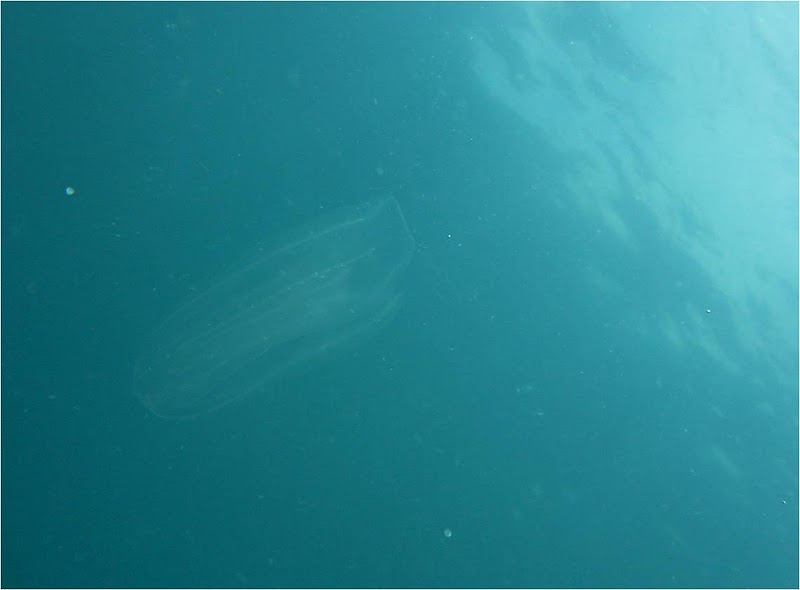
by Rick O'Connor | Apr 17, 2020
I’d like to be a jellyfish… cause jellyfish don’t pay rent…
They don’t walk and they don’t talk with some Euro-trash accent…
Their just simple protoplasm… clear as cellophane
They ride the winds of fortune… life without a brain
These lyrics from Jimmy Buffett’s song Mental Floss sort of sums it up doesn’t it. The easy-going lifestyle of the jellyfish.
Everyone who visits the Gulf coast knows about these guys, but few people… very few… like them. For most, the term jellyfish signals “pain”, “fear”, and “death”. The purple flag is flying, and no one wants to enter the water. Folks from the Midwest call local hotels and condos asking, “when are the jellyfish going to be there?” It’s understandable. Who wants to spend their week vacation on the Gulf inside a hotel because you can’t go swimming?
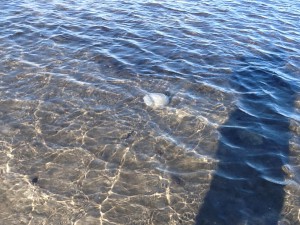
I found this along the shore last winter. These are cannonball jellyfish.
I would almost (…almost) rather be diving with a shark than hundreds of jellyfish. When you spot them, they are everywhere. Quietly swarming like ghosts. You push them off and they appear to move towards you – almost like smoke from a campfire, you can’t get away.
They are creepy things. But amazing too!
As Mr. Buffett’s points out, they are simple “protoplasm”. Their body is primarily a jelly-like substance called mesoglea – and most of that is water. If you place a dead jellyfish on your dock and come back that afternoon, you will probably find just a “stain” of where it was – there is almost nothing to them.
The “bell” of the jellyfish is mostly mesoglea. Some jellyfish have thick layers of this, others much thinner. Some have a small flap of skin along the margins of the bell called the velum which they can undulate and swim – but they are not strong swimmers. If the tide is going out, swim as they may… their heading out also.
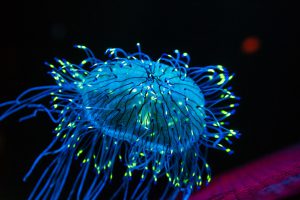
The bell shaped body of a jellyfish with numerous tentacles.
Many species of jellyfish have interesting markings within the bell. One has a white-colored structure that forms a 4-leaf clover. Another has red triangles all connecting at the center of the bell. For many, these structures are the ones that produce the gametes. Jellyfish reproduce sexually but are hermaphroditic – meaning they produce female eggs and male sperm in the same animal. There is no physical contact between animals, they just release the gametes into the ocean when they are in thick swarms and wah-la… new jellyfish – many new jellyfish.
On the bottom of the bell is a single opening that leads to a single pouch. This opening is the mouth, and the pouch is called the gastrovascular cavity. Jellyfish are predators – carnivores. There are no teeth, and most do not seek their prey – their prey finds them. Hanging from their bell are the tools of the killing trade, the part of this animal we do not like… the tentacles. Some tentacles can extend for several feet beyond the bell, others you can hardly notice them – but this is where the killing happens.
Along the tentacles there are small capsules called cnidoblasts which contain small cells called nematocyst. These nematocyst contain a coiled dart which at the end contains a drop of venom. There is a trigger associated with this cell. The jellyfish does not fire it – instead, the prey bumps the trigger and the nematocyst “fires”. The drop of venom is injected, along with the hundreds of other nematocysts along the tentacle the fish just bumped. This venom paralyzes the prey, other tentacles coil around it firing more nematocysts, and the tentacles retract towards the mouth – bingo… lunch.
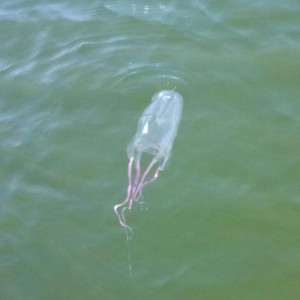
This box jellyfish was found near NAS Pensacola in November of 2015.
Photo: Brad Peterman
Of course, the same happens when people bump into them. For us it is painful and unpleasant – but we are not consumed. That said, some species are quite painful. Some will force people to the hospital, and some have even killed people. The Box Jellyfish is the most notorious of these deadly ones. Known for their habits in Australia, there are at least two species found in the Gulf. The ones found here are not common, and there are no reported deaths, but they do exist. The Four-Handed is the one more widespread here. It actually has eyes, can detect predators and prey and swim towards or away from them, and the male fertilizes the female internally – not your typical jellyfish.
The more familiar painful one is the Portuguese Man-of-War. This creature is more like a sponge in that it is not just one creature but a large “condo” of many. Some cells are specialized in feeding, these are found on their long tentacles. Others specialize in reproduction; these are found near the blue colored air bag. They produce this blueish colored air bag which is exposed above the surface. The wind pushes on the bag like a sail and this moves the creature across the environment in search of food. Hanging from the bag are long tentacles which are made up of individuals whose stomachs are all connected. So, when one group of cells makes contact and kills a prey – they consume it and the tissue is moved through the connecting stomachs to feed the whole colony. To feed a whole colony, you need a big fish – to kill a big fish, you need a strong toxin, and they have it. These are VERY painful and have put people in the hospital, some have died. Some say that the Portuguese man-of-war is not a “true” jellyfish. This is true in the sense that they belong to a different class of jellyfish. There are three classes, the Scyphozoans being what we call the “true” jellyfish – Portuguese man-of-wars are not scyphozoans, but rather hydrozoans.
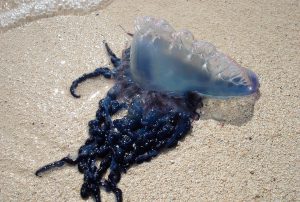
The colonial Portuguese man-of-war.
Photo: NOAA
Another interesting thing about jellyfish, is that they are all not jellyfish-like. As we just mentioned, there are two other classes and one other phylum of jellyfish-like animals. Hydrozoans and anthozoans are not your typical jellyfish. Rather than being bell-shaped and drifting in the ocean looking for food, they are attached to the seafloor and look more like flowers. Their tentacles are usually smaller but do contain nematocysts. Their toxin can be strong, some do eat fish, but most have a weaker toxin and feed on very small creatures – some only eat plankton. These would include the hydra, sea anemones, and the corals. As mentioned above, this also would include the Portuguese man-of-war.
Comb jellies are those jellies that drift in the currents and have no tentacles. We commonly collect them and toss them at each other. When I was growing up, we referred to them as “football jellies” because of this. The reason they do not sting is not because they do not have tentacles (some species do) but rather they do not have nematocyst and cannot. Rather they have special cells called colloblast that produce a drop of sticky glue at the end which they use to capture prey. Not having toxins, they cannot kill large prey but rather feed on smaller creatures like plankton and each other – they are cannibals. For this reason, they are in a whole different phylum.
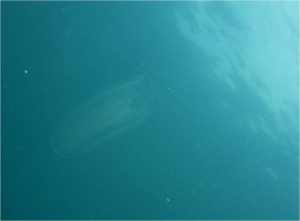
The nonvenmous comb jelly.
Photo: Bryan Fluech
The jellyfish of the Gulf are a nuisance at times but are actually amazing creatures.

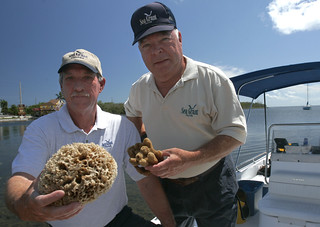
by Rick O'Connor | Apr 5, 2020
We began this series on the Gulf talking about the Gulf itself. We then moved to the big, more familiar – maybe more interesting animals, the vertebrates – birds, fish, etc. In this edition we shift to the invertebrates – the “spineless” animals of the Gulf of Mexico. Many of them we know from shell collecting along the beach, others are popular seafood choices, but most we know nothing about and rarely see.
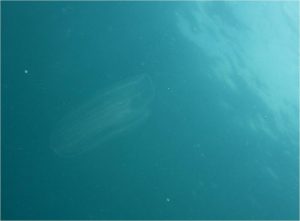
A spineless Comb Jelly.
Florida Sea Grant
They are numerous, on diversity alone – making up 90% of the animal kingdom. They may leave remnants behind so that we know they are there. They may be right in front of our faces, but we do not know what we are looking at. They are incredibly important. Providing numerous nutrient transport, and transfer, in the ecosystem – that would otherwise not exist. They also provide a lot of ecological services that reduce toxins and waste. One source suggests there are over 30 different phyla and over one million species of invertebrates. In this series we will cover six major groups and we begin with the simplest of them all… the sponges.
For some, you may not know that sponges are actually alive. For others, you knew this but were not sure what kind of creature it was. Are they plants? Animals? Just a sponge?
The answer is animal. Yea…
We usually think of animals as having legs, running around, eating things and defecting in places – the kinds of things that make good animal planet shows.
Sponges… would not make a great animal planet show. What are you going to watch? They appear to be doing nothing. They sit on the ocean floor… and… well… that’s it, they sit on the ocean floor. But they actually do a lot.
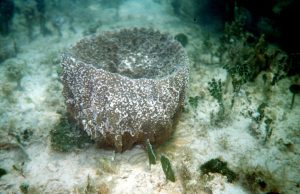
A vase sponge.
Florida Sea Grant
They are considered animal because (a) their cells lack a cell wall – which plants have, and (b) they are heterotrophic… consumers… they have to hunt their food and cannot make it as plants do.
What do they eat?
Plankton. Lots of plankton. Looking at a sponge you would call it one animal, but it is actually a colony of specialized cells working as a unit to survive. There are cells with flagella, called collar cells, that use these flagella to create currents that “suck” water into the body of the creature. This is how they collect plankton. The collar cells live in numerous channels throughout the sponge body connected to small pores all over the service of the sponge. This is where they get their phylum Porifera. As the water moves through the channels, the collar cells remove food and specialized cells called choanocytes release reproductive eggs called gemmules. All of the water eventually collects in a cavity, called the gastrovascular cavity where it exists the sponge through a large opening called an osculum.
This is how they eat and reproduce.
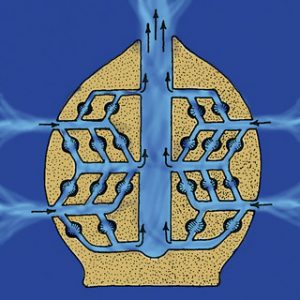
The anatomy of a sponge.
Flickr
The matrix, or tissue, of the sponge is held together by small, hard structures called spicules. It sort of serves as a skeleton for the creature. In different sponges the spicules are made of different materials, and this is how the creatures are divided into classes. Some are made of calcium carbonate, like seashells. Others are made of silica and are “glass-like”, and some made of a softer material called “spongin”, which are the ones we use to take baths with. Today purchased sponges are synthetic, not natural – but you can still get natural sponges.
Many sponges are tiny, others are huge. They all like seawater – not big fans of freshwater – and many produce mild toxins to defend the from predators. They do have predators though – hawksbill sea turtles love them. There is currently a lot of research going on using sponge toxins to kill cancer cells. Who knows, the cure to some forms of cancer may lie in the cavity of the sponge.
Another cool thing about them is that their cavities provide a lot of space for other small creatures in the ocean. Numerous species can be found in sponge tissue and cavities, utilizing this space as a habitat for themselves.
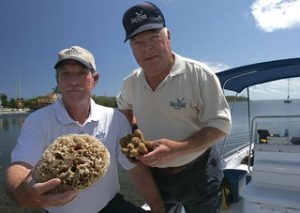
Florida Sea Grant
They are a major player in the development of reefs in the tropics and, like their counter parts coral, have experienced a decline due to over harvesting and harmful algal blooms. There are efforts in the Florida Keys to grow new sponge in aquaculture facilities and “re-plant” in the ocean. In the northern Gulf they are more associated with seagrass beds.
These are truly amazing creatures and the more we learn about them, the more amazing they become.
References:
Myriad World of the Invertebrates. EarthLife. https://www.earthlife.net/inverts/an-phyla.html.
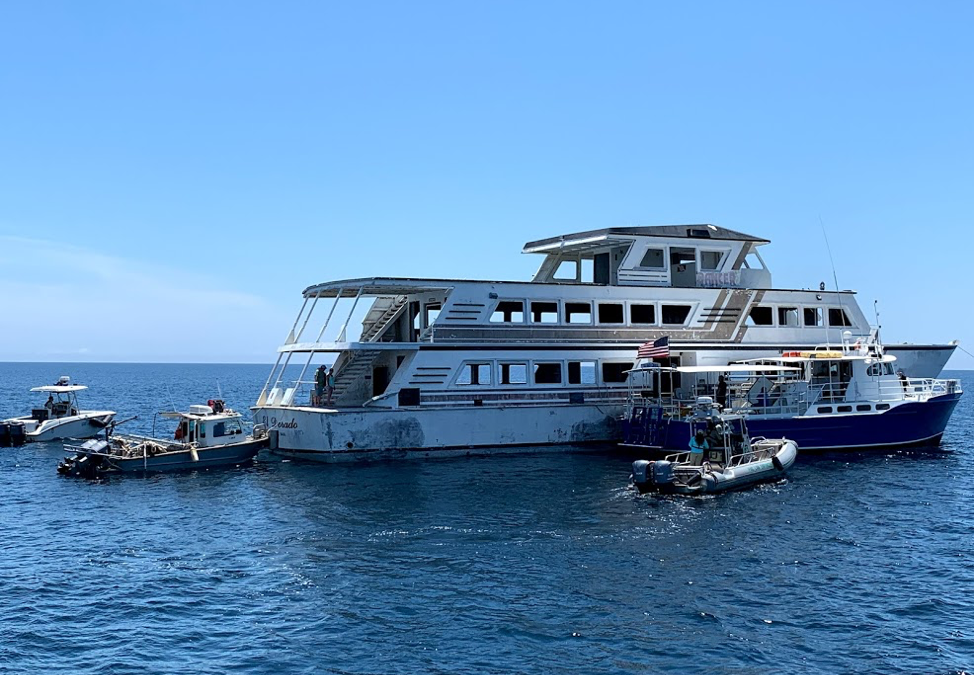
by Scott Jackson | Jun 21, 2019
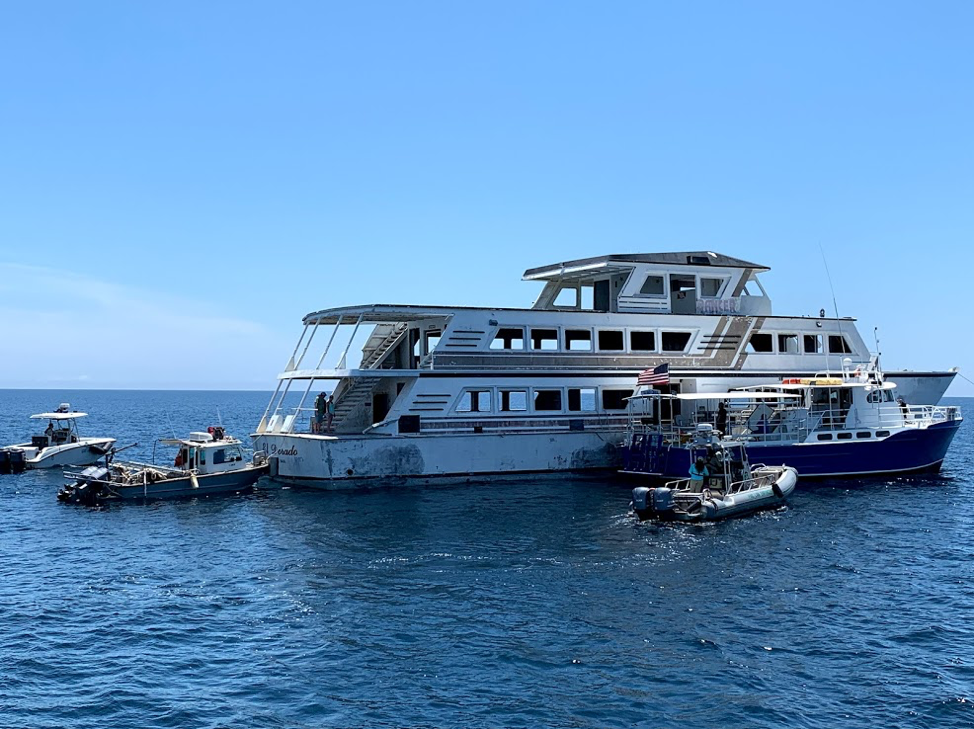
Panama City Dive Center’s Island Diver pulls alongside of the El Dorado supporting the vessel deployment by Hondo Enterprises. Florida Fish and Wildlife crews also are pictured and assisted with the project from recovery through deployment. The 144 foot El Dorado reef is located 12 nautical miles south of St Andrew Pass at 29° 58.568 N, 85° 50.487 W. Photo by L. Scott Jackson.
In the past month, Bay County worked with fishing and diving groups as well as numerous volunteers to deploy two artificial reef projects; the El Dorado and the first of the Natural Resources Damage Assessment (NRDA) reefs.
These sites are in Florida waters but additional opportunities for red snapper fishing are available this year to anglers that book for hire charters with captains holding federal licenses. Federal licensed Gulf of Mexico charters started Red Snapper season June 1st and continue through August 1st. Recreational Red Snapper fishing for other vessels in State and Federal waters is June 11th – July 12th. So booking a federally licensed charter can add a few extra fish to your catch this year.
The conversion of the El Dorado from a storm impacted vessel to prized artificial reef is compelling. Hurricane Michael left the vessel aground in shallow waters. This was in a highly visible location close to Carl Grey Park and the Hathaway Bridge. The Bay County Board of County Commissioners (BOCC) acquired the El Dorado, January 14, 2019 through negotiations with vessel owner and agencies responsible for recovery of storm impacted vessels post Hurricane Michael.
The El Dorado was righted and stabilized, then transported to Panama City’s St Andrews Marina by Global Diving with support from the Coast Guard and Florida Fish and Wildlife. Hondo Enterprises, was awarded a contract to complete the preparation and deployment of the vessel for use as an artificial reef.
Reefing the El Dorado provides new recreational opportunities for our residents and tourists. The new reef delivers support for Bay County’s fishing and diving charters continuing to recover after Hurricane Michael. Several local dive charter captains assisted in the towing and sinking of the El Dorado.
The El Dorado was deployed approximately 12 nm south of St. Andrew Bay near the DuPont Bridge Spans May 2, 2019. Ocean depth in this area is 102 feet, meaning the deployed vessel is accessible to divers at 60 feet below the surface.
The Bay County Board of County Commissioners continues to invest in the county’s artificial reef program just as before Hurricane Michael. Additional reef projects are planned for 2019 – 2020 utilizing Natural Resources Damage Assessment (NRDA) and Resources and Ecosystems Sustainability, Tourist Opportunities, and Revived Economies of the Gulf Coast States Act (RESTORE Act) funds. These additional projects total over 1.3 million dollars utilizing fines as a result of the Deepwater Horizon Oil Spill. Deployments will occur in state waters in sites located to both the east and west of St. Andrew Bay Pass.
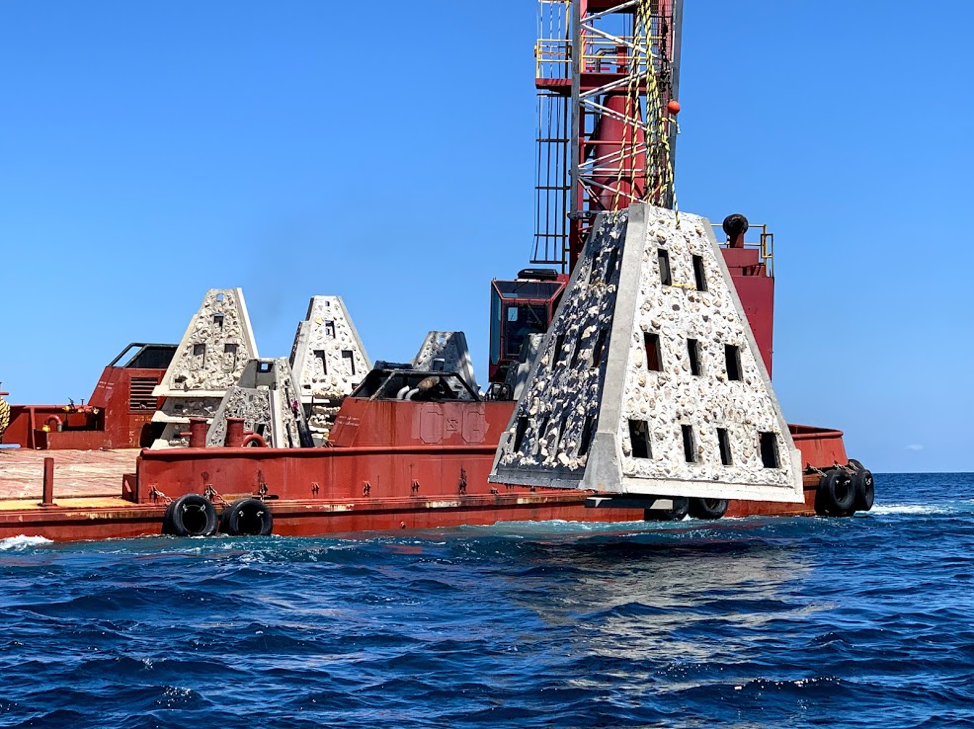
Walter Marine deploys one of nine super reefs deployed in Bay County’s NRDA Phase I project located approximately 12 nautical miles southeast of the St. Andrew Pass. Each massive super reef weighs over 36,000 lbs and is 15 ft tall. Multiple modules deployed in tandem provides equivalent tonnage and structure similar to a medium to large sized scuttled vessel. Photo by Bob Cox, Mexico Beach Artificial Reef Association.
The first of these NRDA deployments for Bay County BOCC was completed May 21, 2019 in partnership with Mexico Beach Artificial Reef Association, Florida Fish and Wildlife Conservation Commission, and Florida Department of Environmental Protection using a $120,000 portion of the total funding. The deployment site in the Sherman Artificial Reef Permit Area is approximately 12 nm south east of St Andrew Bay Pass at a depth of 78 – 80ft.
| Patch Reef # |
Latitude |
Longitude |
| BC2018 Set 1
(6 Super Reefs and 4 Florida Specials) |
29° 55.384 N |
85° 40.202 W |
| BC2018 Set 2
(1 Super Reef and 4 Florida Specials) |
29° 55.384 N |
85° 39.739 W |
| BC2018 Set 3
(1 Super Reef and 4 Florida Specials) |
29° 55.384 N |
85° 39.273 W |
| BC2018 Set 4
(1 Super Reef and 4 Florida Specials) |
29° 55.384 N |
85° 38,787 W |
In 2014, Dr. Bill Huth from the University of West Florida, estimated in Bay County the total artificial reef related fishing and diving economic impact was 1,936 jobs, $131.98 million in economic output and provided $49.02 million in income. Bay County ranked #8 statewide in artificial reef jobs from fishing and diving. Bay County ranked #3 in scuba diving economy and scuba diving was 48.4 % of the total jobs related to artificial reefs. Dr. Huth also determine that large vessels were the preferred type of artificial reef for fishing and diving, with bridge spans and material the next most popular. Scuba diving and fishing on artificial reefs contributes significantly to the county’s economic health.
For more information and assistance, contact UF/IFAS Extension Bay County at 850-784-6105 or Bay@ifas.ufl.edu. Follow us on Facebook at http://faceboook.com/bayifas .
An Equal Opportunity Institution. UF/IFAS Extension, University of Florida, Institute of Food and Agricultural Sciences, Nick T. Place, Dean for UF/IFAS Extension. Single copies of UF/IFAS Extension publications (excluding 4-H and youth publications) are available free to Florida residents from county UF/IFAS Extension offices.
This article is also available through the the Panama City New Herald
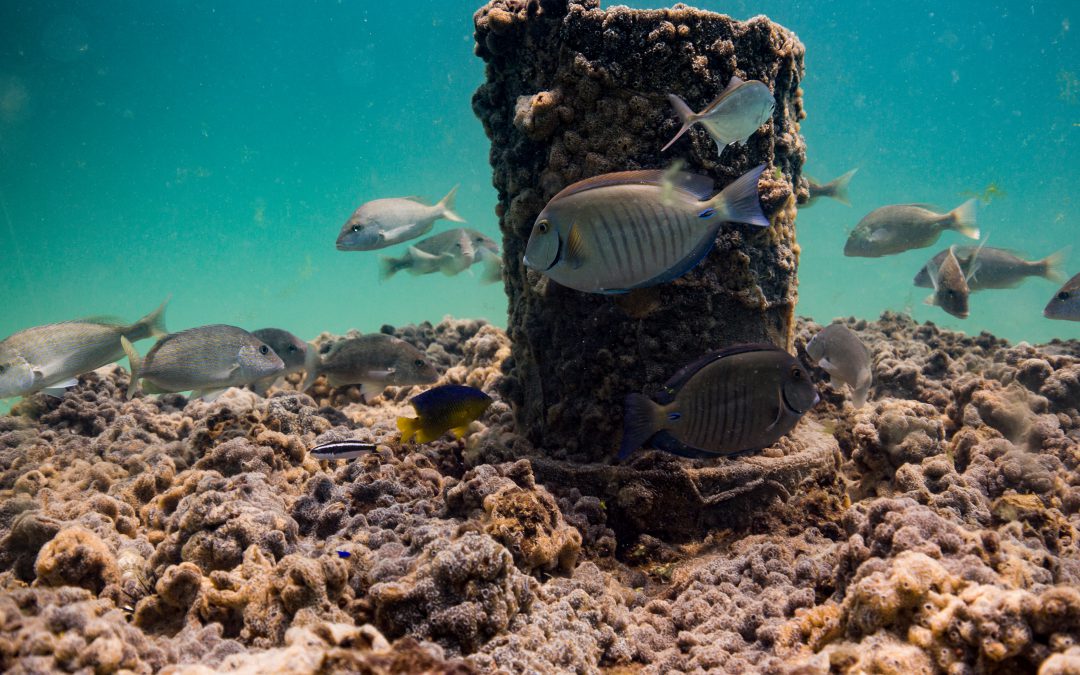
by Laura Tiu | Jan 31, 2019
They say that dreams don’t work unless you take action. In the case of some Walton County Florida dreamers, their actions have transpired into the first Underwater Museum of Art (UMA) installation in the United States. In 2017, the Cultural Arts Alliance of Walton County (CAA) and South Walton Artificial Reef Association (SWARA) partnered to solicit sculpture designs for permanent exhibit in a one-acre patch of sand approximately .7-miles from the shore of Grayton Beach State Park at a depth of 50-60 feet. The Museum gained immediate notoriety and has recently named by TIME Magazine as one of 100 “World’s Greatest Places.” It has also been featured in online and print publications including National Geographic, Lonely Planet, Travel & Leisure, Newsweek, The New York Times, and more.
Seven designs were selected for the initial installation in summer of 2018 including: “Propeller in Motion” by Marek Anthony, “Self Portrait” by Justin Gaffrey, “The Grayt Pineapple” by Rachel Herring, “JYC’s Dream” by Kevin Reilly in collaboration with students from South Walton Montessori School, “SWARA Skull” by Vince Tatum, “Concrete Rope Reef Spheres” by Evelyn Tickle, and “Anamorphous Octopus” by Allison Wickey. Proposals for a second installation in the summer of 2019 are currently being evaluated.
The sculptures themselves are important not only for their artistic value, but also serve as a boon to eco-tourism in the area. While too deep for snorkeling, except perhaps on the clearest of days, the UMA is easily accessible by SCUBA divers. The sculptures are set in concrete and contain no plastics or toxic materials. They are specifically designed to become living reefs, attracting encrusting sea life like corals, sponges and oysters as well large numbers and varieties of fish, turtles and dolphins. This fulfills SWARA’s mission of “creating marine habitat and expanding fishery populations while providing enhanced creative, cultural, economic and educational opportunities for the benefit, education and enjoyment of residents, students and visitors in South Walton.”
The UMA is a diver’s dream and is in close proximity to other Walton County artificial reefs. There are currently four near-shore snorkel reefs available for snorkeling and nine reefs within one mile of the shore in approximately 50-60 feet of water for additional SCUBA opportunities. All reefs are public and free of charge for all visitors with coordinates available on the SWARA website (https://swarareefs.org/). Several SCUBA businesses in the area offer excursions to UMA and the other reefs of Walton County.
For more information, please visit the UMA website at https://umafl.org/ or connect via social media at https://www.facebook.com/umaflorida/.

Schools of fish swim by the turtle reef off of Grayton Beach, Florida. Photo credit: University of Florida / Bernard Brzezinski

by Laura Tiu | Nov 26, 2018
Red Tide has been a persistent presence in the Panhandle since September and responsible for many reported fish kills and respiratory distress in some people. Over the past week, red tide was still present in low to medium concentrations in or offshore of Escambia County to Bay County.

Jack-knife fish killed by red tide Miramar Beach, Florida
Red tide is a natural occurrence and Florida experienced red tides long before humans settled here. The tides originate 10-40 miles off shore and winds and currents bring them inshore. Red tide is fueled by nutrient typically stemming from land-based runoff.
During winter, the northerly winds and southbound currents will push the tide back offshore. There was hope that Hurricane Michael might help carry the red tide back out to sea. Unfortunately, it seems the nutrient run-off from the storm’s heavy rain or retreating storm surge may have contributed to the intensity and duration of the bloom.
In our economy, which is heavily dependent on tourism, the red tide is continuing to take a toll, especially on waterfront businesses. According to the Florida Fish and Wildlife Conservation Commission, store-bought and restaurant served shellfish are safe to eat during a red tide bloom because shellfish are monitored for safety and tested for red tide toxins before they are sold. The edible parts of crabs, shrimp and fish are not affected by the red tide organism and can be eaten, but guts should be discarded.
Many remember the local red tide bloom in 2015. The longest red tide bloom ever recorded lasted 30 months from 1994 to 1997. Warmer water due to climate change is predicted to cause algae to bloom more often, more intensely, and in more water bodies. It is imperative that we reduce nutrient inputs to our lakes, rivers, estuaries and coastal ocean waters today.
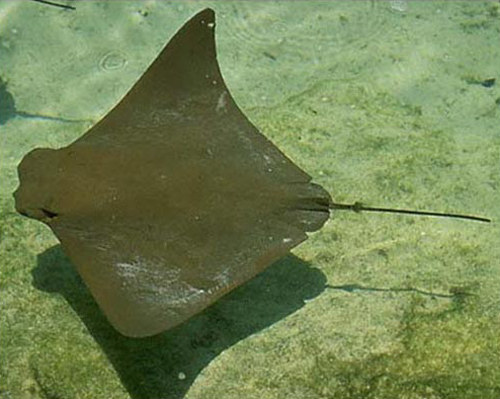
by Rick O'Connor | May 31, 2018
It is now late May and in recent weeks I, and several volunteers, have been surveying the area for terrapins, horseshoe crabs, and monitoring local seagrass beds. We see many creatures when we are out and about; one that has been quite common all over the bay has been the “stingray”.
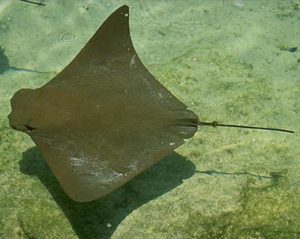
The cownose ray is often mistaken for the manta ray. It lacks the palps (“horns”) found on the manta.
Photo: Florida Sea Grant
These are intimidating creatures… everyone knows how they can inflict a painful wound using the spine in their tail, but may are not aware that not all “stingrays” can actually use a spine to drive you off – actually, not all “rays” are “stingrays”.
So what is a ray?
First, they are fish – but differ from most fish in that they lack a bony skeleton. Rather it is cartilaginous, which makes them close cousins of the sharks.
So what is the difference between a shark and a ray?
You would immediately jump on the fact that rays are flat disked-shape fish, and that sharks are more tube-shaped and fish like. This is probably true in most cases, but not all. The characteristics that separate the two groups are
- The five gill slits of a shark are on the side of the head – they are on the ventral side (underside) of a ray
- The pectoral fin begins behind the gill slits in sharks, in front of for the ray group
Not all rays have the whip-like tail that possess a sharp spine; some in fact have a tube-shaped body with a well-developed caudal fin for a tail.
There are eight families and 19 species of rays found in the Gulf of Mexico. Some are not common, but others are very much so.
Sawfish are large tube-shaped rays with a well-developed caudal fin. They are easily recognized by their large rostrum possessing “teeth” giving them their common name. Walking the halls of Sacred Heart Hospital in Pensacola, you will see photos of fishermen posing next to monsters they have captured. Sawfish can reach lengths of 18 feet… truly intimidating. However, they are very slow and lethargic fish. They spend their lives in estuaries, rarely going deeper than 30 feet. They were easy targets for fishermen who displayed them as if they caught a true monster. Today they are difficult to find and are protected. There are still sightings in southwest Florida, and reports from our area, but I have never seen one here. I sure hope to one day. There are two species in the Gulf of Mexico.
Guitarfish are tube-shaped rays that are very elongated. They appear to be sharks, albeit their heads are pretty flat. They more common in the Gulf than the bay and, at times, will congregate near our reefs and fishing piers to breed. They are often confused with the electric rays called torpedo rays, but guitarfish lack the organs needed to deliver an electric shock. They have rounded teeth and prefer crustaceans and mollusk to fish. There is only one species in the Gulf.
Torpedo rays can deliver an electric shock – about 35 volts of one. Though there are stories of these shocking folks to death, I am not aware of any fatalities. Nonetheless, the shock can be serious and beach goers are warned to be cautious. I once mistook one buried in the sand for a shell. Let us just say the jolt got my attention and I may have had a few words for this fish before I returned to the beach. We have two species of torpedo rays in the Gulf of Mexico.
Skates look JUST like stingrays – but they lack the whip-like tail and the venomous spine that goes with it. They are very common in the inshore waters of the Florida Panhandle and though they lack the terrifying spine we are all concerned about, they do possess a series of small thorn-like spine on the back that can be painful to the bare foot of a swimmer. Skates are famous for producing the black egg case folks call the “mermaids’ purse”. These are often found dried up along the shore of both the Gulf and they bay and popular items to take home after a fun day at the beach. There are four species of skates found in the Gulf of Mexico.
Stingrays… this is the one… this is the one we are concerned about. Stingrays can be found on both sides of our barrier islands and like to hide beneath the sand to ambush their prey. More often than not, when we approach they detect this and leave. However, sometimes they will remain in the sand hoping not to be detected. The swimmer then steps on their backs forcing them to whip their long tail over and drive the serrated spine into your foot. This usually makes you move off them – among other things. The piercing is painful and spine (which is actually a modified tooth) possesses glands that contain a toxic substance. It really is no fun to be stung by these guys. Many people will do what is called the “stingray shuffle” as they move through the water. This is basically sliding your feet across the sand reducing your chance of stepping on one. They are no stranger to folks who visit St. Joe Bay. The spines being modified teeth can be easily replaced after lodging in your foot. Actually, it is not uncommon to find one with two or three spines in their tails ready to go. Stingrays do not produce “mermaids’ purses” but rather give live birth. There are five species in the Gulf of Mexico.
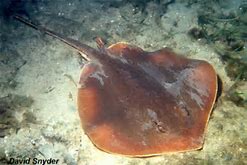
The Atlantic Stingray is one of the common members of the ray group who does possess a venomous spine.
Photo: Florida Museum of Natural History
Butterfly ray is a strange looking fish and easy to recognize. The wide pectoral fins and small tail gives it the appearance of a butterfly. Despite the small tail, it does possess a spine. However, the small tail makes it difficult for the butterfly ray to pierce you with it. There is only one species in the Gulf, the smooth butterfly ray.
Eagle rays are one of the few groups of rays that actually in the middle of the water column instead of sitting on the ocean floor. They can get quite large and often mistaken for manta rays. Eagle rays lack the palps (“horns”) that the manta ray possesses. Rather they have a blunt shaped head and feed on mollusk. They do have venomous spines but, as with the butterfly ray, their tails are too short to extend and use it the way stingrays do. There are two species. The eagle ray is brown and has spots all over its back. The cownose ray is very common and almost every time I see one, I hear “there go manta rays”… again, they are not mantas. They have a habit of swimming in the surf and literally body surfing. Surfers, beachcombers, and fishermen frequently see them.
Last but not least is the very large Manta ray. This large beast can reach 22 feet from wingtip to wing tip. Like eagle rays, they swim through the ocean rather than sit on the bottom. They have to large “horns” (called palps) that help funnel plankton into their mouths. These horns give them one of their common names – the devilfish. Mantas, like eagle and butterfly rays, do have whip-like tails and a venomous spine, but like the above, their tails are much shorter and so effective placement of the spine in your foot is difficult.
Many are concerned when they see rays – thinking that all can inflict a painful spine into your foot – but they are actually really neat animals, and many are very excited to see them.
References
Hoese, H.D., R.H. Moore. 1977. Fishes of the Gulf of Mexico; Texas, Louisiana, and Adjacent Waters. Texas A&M. College Station, TX. pp. 327.
Shipp, R. L. 2012. Guide to Fishes of the Gulf of Mexico. KME Seabooks. Mobile AL. pp. 250.






















